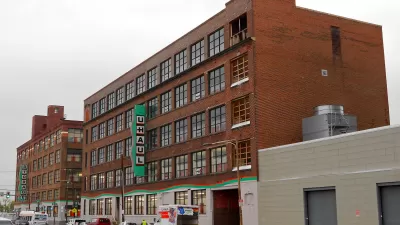While protected bike lanes have yet to be recognized by AASHTO, they are en route to being recognized by US DOT, writes Green Lane Project's Michael Andersen. With federal guidance, transportation engineers may be more willing to build cycle tracks.
With federal recognition that lanes protected from traffic are safer than lanes only separated by a narrow, white line, will the American Association of State Highway and Transportation Officials (AASHTO) follow suit? As noted here last year, the National Association of City Transportation Officials' (NACTO) Urban Bikeway Design Guide was the first to provide engineering guidance for protected bike lanes, also called cycle tracks.
Anderson writes that in "a task order proposal request quietly circulated to selected contractors last week, the (Federal Highway Administration or FHWA) that oversees U.S. road design did exactly what many biking advocates have been urging it to do for years: It suggested that physically separated bikeways can be welcome improvements to American streets and kicked off a process intended to prove it."
"There is a growing body of research on cycle tracks in the U.S. and Canada indicating that, when they are designed well, they do not increase bike crash rates," the agency's document reads. "There is also growing evidence that cyclists prefer cycle tracks."
Speaking of Canada, Streetsblog's Angie Schmitt writes on August 07 that a "study published in the Journal of Transport and Land Use [PDF] found that intersections in Montreal with protected bike lanes see 61 percent more bike traffic than those without."
Safety is the key element that increases cycling numbers among the greater population. Protected bike lanes attract those who are less willing to bike for fear of being hit by motor vehicles, as this August 07 Seattle Times "Editorial: Seattle is playing catch-up on bike safety", illustrates:
Three of those (bike-car collisions) occurred on Dexter Avenue, sending two cyclists to the hospital. Dexter is a designated, high-traffic bike route, but the collisions show that painted bike lanes are doing an inadequate job of separating drivers and cyclists.
Anderson writes about the first steps FHWA is taking to giving "a federal stamp of approval for a [sic] cycle tracks", in the words of John Cameron, chief engineer for the City of Memphis, one of six cities that the Bikes Belong Foundation selected to "Fast Track Protected Bike Lanes".
As ordered by the FHWA, the forthcoming study will look at crash rates and types at 10 to 20 locations that currently offer physically separated cycle tracks, creating a set of recommended design standards and guidelines that FHWA's influence might eventually integrate into the two bibles of U.S. road design: the Manual of Uniform Traffic Control Devices (MUTCD), which discusses traffic signs, signals and markings; and the American Association of State Highway and Transportation Officials road design guide, which discusses the shapes and materials of safe roadways.
FULL STORY: Green Lane Project: At Last! Feds Move Toward A Green Light For Separated Bike Lanes

Manufactured Crisis: Losing the Nation’s Largest Source of Unsubsidized Affordable Housing
Manufactured housing communities have long been an affordable housing option for millions of people living in the U.S., but that affordability is disappearing rapidly. How did we get here?

Americans May Be Stuck — But Why?
Americans are moving a lot less than they once did, and that is a problem. While Yoni Applebaum, in his highly-publicized article Stuck, gets the reasons badly wrong, it's still important to ask: why are we moving so much less than before?

Using Old Oil and Gas Wells for Green Energy Storage
Penn State researchers have found that repurposing abandoned oil and gas wells for geothermal-assisted compressed-air energy storage can boost efficiency, reduce environmental risks, and support clean energy and job transitions.

Greening Oakland’s School Grounds
With help from community partners like the Trust for Public Land, Oakland Unified School District is turning barren, asphalt-covered schoolyards into vibrant, green spaces that support outdoor learning, play, and student well-being.

California Governor Suspends CEQA Reviews for Utilities in Fire Areas
Utility restoration efforts in areas affected by the January wildfires in Los Angeles will be exempt from environmental regulations to speed up the rebuilding of essential infrastructure.

Native American Communities Prepare to Lead on Environmental Stewardship
In the face of federal threats to public lands and conservation efforts, indigenous groups continue to model nature-centered conservation efforts.
Urban Design for Planners 1: Software Tools
This six-course series explores essential urban design concepts using open source software and equips planners with the tools they need to participate fully in the urban design process.
Planning for Universal Design
Learn the tools for implementing Universal Design in planning regulations.
Heyer Gruel & Associates PA
City of Moreno Valley
Institute for Housing and Urban Development Studies (IHS)
City of Grandview
Harvard GSD Executive Education
Salt Lake City
NYU Wagner Graduate School of Public Service
City of Cambridge, Maryland




























